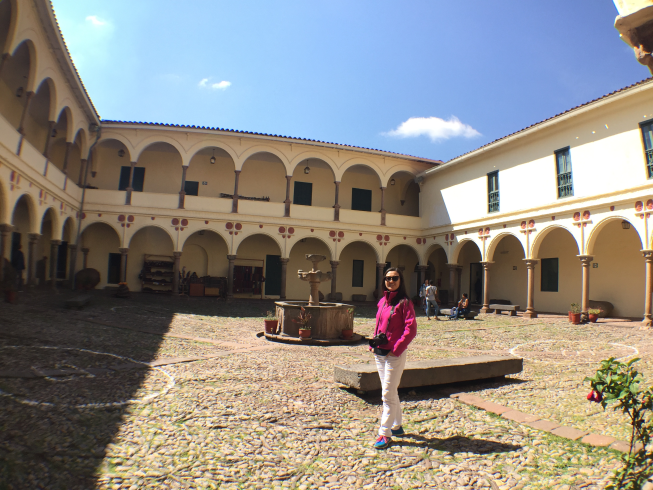

My first glance of Cusco on on our way to Ollantaytambo was a rather disappointment. It was dirty, dusty, chaotic, disarrayed houses with odd colors, gridlock, and the never ceasing headache-induced car honking. Nothing pleasing to me sensually that I even second guessed my decision of spending 3 days here after our visit in Machu Picchu.
However, the historical district of Cusco was spectacular. The brick buildings and terra cotta roofs are lovely in the daylight.

Cusco is one place that I would intentionally get lost.
Our hostel was in a perfect location, on the old Incan Road, just steps away from the famed Cusco cathedral.Cusco has so many details to appreciate, so many narrow ancient pedestrian-only cobblestone streets, so many endless rows of slippery cobblestone stairs, so many colonial Spanish buildings with wooden railing balconies and walls made with vast Inca stones, and so many big old faded big doors that I obsessed. It was impossible to capture the nuanced details of Cusco within a few days.
I sincerely enjoyed my stay in Cusco.



 Travellers can take the old Incan Road up many steps to ‘great stone street’ and see the famed 12-angled stone, a marvel of stonework set into the best kept Incan walls in Cusco. Notice how well the stones have been extremely well carved so they fit into each other.
Travellers can take the old Incan Road up many steps to ‘great stone street’ and see the famed 12-angled stone, a marvel of stonework set into the best kept Incan walls in Cusco. Notice how well the stones have been extremely well carved so they fit into each other. North of the Plaza de Armas, San Blas is one of Cusco’s most picturesque neighbourhoods and requires some lung workout to reach after walking up through endless rows of cobblestone stairs. . This pedestrian-only area of Cusco is great for exploring the ancient stone streets. The efforts are rewarded by the artist workshops and studios, captivating little cafes and of course the postcard-worthy views of the city.
North of the Plaza de Armas, San Blas is one of Cusco’s most picturesque neighbourhoods and requires some lung workout to reach after walking up through endless rows of cobblestone stairs. . This pedestrian-only area of Cusco is great for exploring the ancient stone streets. The efforts are rewarded by the artist workshops and studios, captivating little cafes and of course the postcard-worthy views of the city. The huge ancient door..
The huge ancient door.. There were many blue color doors.
There were many blue color doors. San Pedro market. I saw this at San Pedro market. It looked like Guinea pig, but unsure. The guinea pig we ordered at the restaurant was very tasty, tastier than llama and alpace.
San Pedro market. I saw this at San Pedro market. It looked like Guinea pig, but unsure. The guinea pig we ordered at the restaurant was very tasty, tastier than llama and alpace. Ceviche: my favorite raw trout fish from lake Titicaca..
Ceviche: my favorite raw trout fish from lake Titicaca.. It is common to see indigenous people earning money by providing photo opportunity with the beautiful cute Alpaca.
It is common to see indigenous people earning money by providing photo opportunity with the beautiful cute Alpaca. Sacsayhuaman - a ruin site within the walking distance from Cusco historical center.
Sacsayhuaman - a ruin site within the walking distance from Cusco historical center.blog comments powered by Disqus